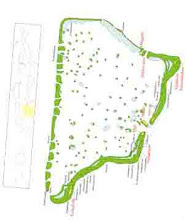 Japan, again, to display of my favorites sites - Fushimi Inari Taisha (or Fushimi Inari Shrine). Fushimi Inari Shrine is a Shinto shrine dedicated to Inari, the god of rice, sake, and prosperity. "Fushimi" is simply the location, added to the name to distinguish it from other Inari shrines. Is one of Kyoto's oldest (founded in 711 AD) and most revered Shinto shrines, Fushimi Inari serves as the headquarters for all the 40,000 shrines dedicated to Inari across Japan. Originally the god of rice, Inari now governs the modern equivalent: success and prosperity in business. Fushimi Inari Shrine draws thousands of businessmen and trades people seeking blessings for their enterprises, especially at the first prayers of the New Year. Fushimi Inari is noted for its remarkable sight of some 10,000 small torii (shrine gates) that arch over a long path up the hill behind the shrine. It takes about two hours to walk along the whole trail, but the experience is unique since it seams like we are walking in to a gigantic, endless orange tunnel. Donated and inscribed by businesses and individuals thankful for their prosperity, the long tunnel of torii is one of the most iconic visions of Kyoto. If possible, visit Furshimi Inari early in the morning since it is genuine worship place and is open since dark. That was what I did, and I felt wander walking alone through the tunnels of torii in the quiet woods. It is a magical experience: as the daylight start, the fresh fog vanishes in to the woods. Foxes are said to be the messengers of Inari, and stern bronze foxes (kitsune) can be seen throughout the shrine. Inari's foxes are generally considered helpful, but they have also been said to bewitch people. The keys that some of them hold in their mouths are for the rice granaries.
Japan, again, to display of my favorites sites - Fushimi Inari Taisha (or Fushimi Inari Shrine). Fushimi Inari Shrine is a Shinto shrine dedicated to Inari, the god of rice, sake, and prosperity. "Fushimi" is simply the location, added to the name to distinguish it from other Inari shrines. Is one of Kyoto's oldest (founded in 711 AD) and most revered Shinto shrines, Fushimi Inari serves as the headquarters for all the 40,000 shrines dedicated to Inari across Japan. Originally the god of rice, Inari now governs the modern equivalent: success and prosperity in business. Fushimi Inari Shrine draws thousands of businessmen and trades people seeking blessings for their enterprises, especially at the first prayers of the New Year. Fushimi Inari is noted for its remarkable sight of some 10,000 small torii (shrine gates) that arch over a long path up the hill behind the shrine. It takes about two hours to walk along the whole trail, but the experience is unique since it seams like we are walking in to a gigantic, endless orange tunnel. Donated and inscribed by businesses and individuals thankful for their prosperity, the long tunnel of torii is one of the most iconic visions of Kyoto. If possible, visit Furshimi Inari early in the morning since it is genuine worship place and is open since dark. That was what I did, and I felt wander walking alone through the tunnels of torii in the quiet woods. It is a magical experience: as the daylight start, the fresh fog vanishes in to the woods. Foxes are said to be the messengers of Inari, and stern bronze foxes (kitsune) can be seen throughout the shrine. Inari's foxes are generally considered helpful, but they have also been said to bewitch people. The keys that some of them hold in their mouths are for the rice granaries.
Ponto de partida e de chegada. Lisboa
-
Às vezes tento ler o meu futuro. Não nos astros, nem nas cartas, nem na
palma da mão. Tento lê-lo dentro de mim. Mas encontro tantas páginas soltas
que nã...





















